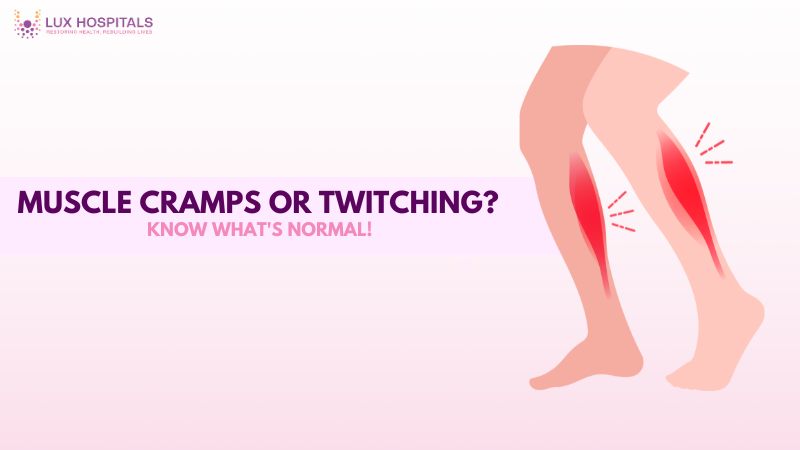Muscle Cramps and Twitching: What Your Body Is Telling You

Muscle cramps and twitching are sensations most people experience at some point. Whether it’s a sudden charley horse in the middle of the night or an eyelid that won’t stop fluttering, these symptoms can be alarming, especially if they happen frequently. While most cases are harmless and short-lived, others could be early indicators of more serious health issues. issues, including nerve or muscular disorders.
In this blog, we’ll explore the causes, symptoms, and treatment options for muscle cramps and twitching, helping you understand what your body is trying to tell you. By the end, you’ll know what’s considered normal, what might require a doctor’s attention, and how to prevent future episodes.
What are Muscle Cramps and Twitching?
Muscle cramps are sudden, involuntary spasms of one or more muscles. That can be very painful. They most commonly affect the legs, particularly the calf muscles. Conversely, twitching refers to small, involuntary muscle movements or spasms that are usually painless.
Both muscle cramps and twitching can occur in healthy individuals. However, if they are severe or chronic, they may indicate a problem with the nerves or muscles. Managing symptoms and avoiding recurrence may be made easier by being aware of their underlying causes.
Common Causes of Muscle Cramps
Muscle cramps often occur due to dehydration, overuse, or prolonged physical activity. They can also be triggered by poor blood circulation, mineral deficiencies, or nerve compression. Here are common reasons behind muscle cramps:
1. Dehydration and Electrolyte Imbalance
A lack of water or essential minerals like potassium, magnesium, and calcium often triggers muscle cramps and twitching. This is especially common among athletes and people who work in hot environments. Your risk can be significantly reduced by maintaining proper electrolyte balance and hydration.
2. Overuse and Muscle Fatigue
People who strain their muscles too hard without appropriate rest can experience twitches and cramping during exercise. Muscle fatigue brought on by prolonged standing, walking, or lifting might result in cramping. To avoid this, proper warm-ups and cool-downs are crucial.
3. Poor Blood Circulation
Restricted blood flow due to vascular issues can also lead to muscle cramps. People with peripheral artery disease or those who spend too much time sitting still may have agonizing leg cramps. Regular movement and medical evaluation can help control this issue.
Common Causes of Muscle Twitching
Muscle twitching is usually harmless and often results from fatigue, stress, or nutrient deficiencies. However, persistent twitching may indicate underlying nerve or muscular conditions. Here are brief lines for each common reason
1. Stress and Anxiety
Muscle cramps and twitching are often linked to heightened stress levels or anxiety. The body’s response to stress includes the release of neurotransmitters that can overstimulate muscles. Practicing relaxation techniques can minimize stress-induced twitching.
2. Caffeine or Stimulant Intake
Too much caffeine or other stimulants can cause small muscle groups to twitch uncontrollably. These twitches are usually temporary and resolve once stimulant levels decrease. Reducing intake can help prevent these episodes.
3. Nerve Irritation or Damage
Sometimes, persistent muscle cramps and twitching may be due to nerve compression or damage. Conditions like carpal tunnel syndrome, sciatica, or even multiple sclerosis can result in such symptoms. A neurologist should evaluate chronic or worsening symptoms.
When Muscle Cramps and Twitching Are Normal?
Muscle cramps and twitching are considered normal when:
- They sporadically appear, particularly following physical activity or extended periods of inactivity.
- They go away within minutes or after stretching
- They are not accompanied by muscle weakness or significant pain
These symptoms are usually harmless and self-limiting, especially in healthy individuals or those under temporary stress or exertion.
When to See a Doctor?
You should consult a healthcare provider if:
- Muscle cramps and twitching are frequent or worsen over time
- They are accompanied by muscle weakness, numbness, or loss of coordination
- They interfere with sleep, daily activities, or quality of life
Persistent muscle cramps and twitching could signal serious issues such as ALS, neuropathy, or electrolyte disorders that require medical attention.
Prevention and Home Remedies
1. Stay Hydrated
Drink enough water throughout the day, especially if you exercise or live in hot climates. Add electrolyte-rich drinks during strenuous activities.
2. Stretch Regularly
Gentle stretching before and after physical activity helps reduce your chances of getting muscle cramps. Include yoga or foam rolling as part of your routine.
3. Maintain a Balanced Diet
Eat foods rich in magnesium, potassium, and calcium, such as bananas, spinach, yoghurt, and nuts. Proper nutrition supports healthy muscle function.
4. Limit Caffeine and Stress
Reducing caffeine intake and managing stress through mindfulness, exercise, or therapy can significantly reduce muscle twitching episodes.
Conditions That May Cause Chronic Symptoms
1. Amyotrophic Lateral Sclerosis (ALS)
One of the severe neurological conditions is linked with chronic muscle cramps and twitching. ALS affects nerve cells in the brain and spinal cord.
2. Multiple Sclerosis (MS)
Due to nerve fiber damage, MS can cause random muscle twitching, cramping, and weakness. It’s often accompanied by fatigue, vision changes, or tingling sensations.
3. Peripheral Neuropathy
This condition damages the peripheral nerves and may cause chronic pain, twitching, and muscle cramping. Diabetes is a leading cause.
Conclusion
Muscle cramps and twitching are often benign and transient, particularly when they are caused by stress, dehydration, or overuse. However, if they become uncomfortable and regular, or if they are accompanied by other symptoms like weakness or numbness, they may be a sign of a more serious illness. You can take the appropriate action, like increasing your water intake, lowering your stress level, or getting medical care, if you know what is normal and what isn’t. Muscle cramps and twitches can be prevented by taking preventative steps, including stretching, maintaining a healthy diet, and controlling stress. Always pay attention to your body, and if symptoms continue, see a doctor.
Frequently Asked Questions
Random muscle twitches are often benign and caused by stress, fatigue, or caffeine. They usually resolve without treatment. If they persist or are accompanied by weakness, consult a doctor.
Muscle cramps and twitching can be early signs of ALS, but they are also common in non-serious conditions. ALS symptoms typically include muscle weakness and loss of motor control. See a neurologist if symptoms persist or worsen.
Prevention strategies include staying well-hydrated, maintaining electrolyte balance (through diet or supplements), and incorporating regular stretching and conditioning into your routine. Reducing caffeine and nicotine intake, managing stress, and ensuring adequate rest can help minimize twitching.
Muscle cramps are sudden, involuntary, often painful contractions commonly triggered by dehydration, overuse, fatigue, or low electrolytes (potassium, calcium, magnesium). Twitching (fasciculations), on the other hand, is typically a fine, involuntary muscle fiber movement caused by minor factors like stress, caffeine, fatigue, or mild nutrient imbalance. Both cramps and twitches can occasionally signal underlying conditions, but most cases are due to simple lifestyle factors.
Occasional, brief, isolated twitching (especially in eyelids or calves) is generally benign and common in healthy individuals. Persistent twitching, especially if accompanied by muscle weakness, atrophy, numbness, or slowed movement, could indicate neurological disorders like ALS, neuropathy, or myopathy.




















